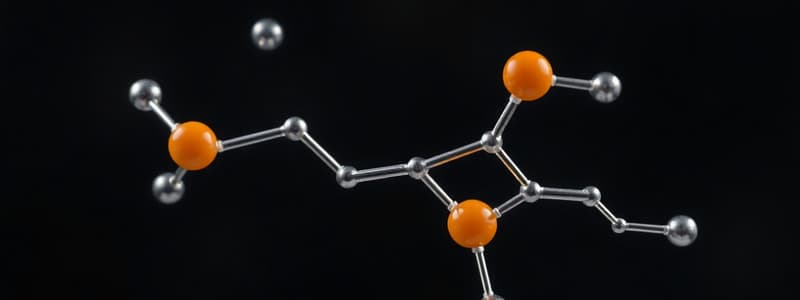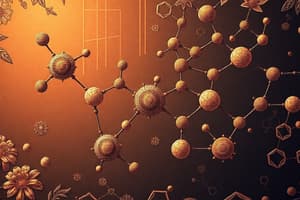Podcast
Questions and Answers
What structural feature distinguishes a ketose from an aldose?
What structural feature distinguishes a ketose from an aldose?
- A ketose contains a carbonyl group elsewhere than the end of the carbon chain, while an aldose has it at the end. (correct)
- A ketose is a disaccharide, while an aldose is a monosaccharide.
- A ketose forms five-membered rings, while an aldose forms six-membered rings.
- A ketose contains a carbonyl group at the end of the carbon chain, while an aldose has it elsewhere.
If a carbohydrate molecule has 5 chiral carbons, how many stereoisomers are possible for that carbohydrate?
If a carbohydrate molecule has 5 chiral carbons, how many stereoisomers are possible for that carbohydrate?
- 64
- 10
- 5
- 32 (correct)
During the cyclization of a monosaccharide, what chemical event leads to ring formation?
During the cyclization of a monosaccharide, what chemical event leads to ring formation?
- Water is added across a double bond.
- A hydroxyl group attacks the carbonyl carbon. (correct)
- A carbon-carbon bond is formed between two non-adjacent carbons.
- An amino group replaces a hydroxyl group.
What is the defining characteristic of an anomeric carbon?
What is the defining characteristic of an anomeric carbon?
In the context of carbohydrate chemistry, what does mutarotation describe?
In the context of carbohydrate chemistry, what does mutarotation describe?
What is the primary role of starch in plants?
What is the primary role of starch in plants?
What type of polysaccharide are amylose and amylopectin?
What type of polysaccharide are amylose and amylopectin?
What type of glycosidic linkage is found in amylose?
What type of glycosidic linkage is found in amylose?
In addition to alpha 1-4 linkages, what other type of glycosidic linkage is present in amylopectin?
In addition to alpha 1-4 linkages, what other type of glycosidic linkage is present in amylopectin?
Compared to amylopectin, what is a key structural difference in glycogen?
Compared to amylopectin, what is a key structural difference in glycogen?
Why does increased branching in glycogen lead to faster glucose mobilization?
Why does increased branching in glycogen lead to faster glucose mobilization?
What type of glycosidic linkage is characteristic of both cellulose and chitin?
What type of glycosidic linkage is characteristic of both cellulose and chitin?
Why can't humans digest beta 1-4 glycosidic linkages found in cellulose?
Why can't humans digest beta 1-4 glycosidic linkages found in cellulose?
If a monosaccharide is determined to be a D-sugar, what does this indicate about the position of the hydroxyl group on the chiral carbon furthest from the carbonyl?
If a monosaccharide is determined to be a D-sugar, what does this indicate about the position of the hydroxyl group on the chiral carbon furthest from the carbonyl?
What are epimers in carbohydrate chemistry?
What are epimers in carbohydrate chemistry?
What is a common structural feature of carbohydrates?
What is a common structural feature of carbohydrates?
Considering the ratio of carbon to water molecules in carbohydrates, how many water molecules are associated with a carbohydrate containing 6 carbon atoms?
Considering the ratio of carbon to water molecules in carbohydrates, how many water molecules are associated with a carbohydrate containing 6 carbon atoms?
In the context of alpha and beta isomers, where is the hydroxyl group positioned in a beta isomer?
In the context of alpha and beta isomers, where is the hydroxyl group positioned in a beta isomer?
What is always involved in the cyclization of carbohydrates?
What is always involved in the cyclization of carbohydrates?
What is TRUE regarding non-reducing ends in polysaccharides?
What is TRUE regarding non-reducing ends in polysaccharides?
Flashcards
Carbohydrates
Carbohydrates
Hydrates of carbon
Carbonyl carbon
Carbonyl carbon
Carbon with a double bonded oxygen
Epimers
Epimers
Molecules differing in configuration at one chiral carbon
Ketose
Ketose
Signup and view all the flashcards
Aldose
Aldose
Signup and view all the flashcards
Anomeric carbon
Anomeric carbon
Signup and view all the flashcards
Aldoses anomeric carbon
Aldoses anomeric carbon
Signup and view all the flashcards
Ketoses anomeric carbon
Ketoses anomeric carbon
Signup and view all the flashcards
Mutarotation
Mutarotation
Signup and view all the flashcards
Amylose
Amylose
Signup and view all the flashcards
Amylopectin
Amylopectin
Signup and view all the flashcards
Glycogen
Glycogen
Signup and view all the flashcards
Non-reducing ends
Non-reducing ends
Signup and view all the flashcards
Chitin and cellulose
Chitin and cellulose
Signup and view all the flashcards
Beta 1-4 linkages
Beta 1-4 linkages
Signup and view all the flashcards
Study Notes
- Carbohydrates are hydrates of carbon.
- Every carbon molecule is associated with one water molecule.
- Carbohydrates contain multiple chiral carbons.
- Stereoisomer amount calculation: 2^n (n = # of chiral carbons).
- D or L configuration is based on the chiral carbon furthest from the carbonyl carbon.
- Carbonyl carbon is a carbon with a double-bonded oxygen.
- Epimers are two molecules differing in configuration at a single chiral carbon.
- Ketose: The carbonyl group is located anywhere other than the end of the chain.
- Aldose: The carbonyl group is located at the end of the chain.
- Cyclic structures are formed with carbohydrates that have 5+ carbons.
- Cyclization occurs when a hydroxyl group within the sugar attacks the carbonyl carbon.
- Cyclization always involves a carbonyl group.
- Anomeric carbon: the carbon that becomes chiral after cyclization.
- In aldoses, carbon 1 is anomeric.
- In ketoses, carbon 2 is anomeric.
- Alpha isomers: Hydroxyl group below the plane of the sugar.
- Beta isomers: Hydroxyl group above the plane of the sugar.
- Mutarotation involves the interconversion of alpha and beta forms through a cyclic intermediate.
- Starch is used for energy storage in plants and is composed of amylopectin and amylose.
- Both amylopectin and amylose are homopolysaccharides.
- Amylose consists of a linear homopolysaccharide of glucose joined by alpha 1-4 linkages.
- Amylopectin consists of glucose residues joined by alpha 1-4 linkages with alpha 1-6 branch points about every 25 residues.
- Glycogen consists of branched homopolysaccharides with alpha 1-4 main chains and alpha 1-6 branch points.
- Glycogen has a high frequency of branching, with a branch about every 9 residues.
- Greater branching in glycogen results in more non-reducing ends.
- More non-reducing ends allow glucose stores to be mobilized faster.
- Chitin and cellulose utilize beta 1-4 linkages to form elongated structures.
- Humans cannot break down beta 1-4 linkages without the necessary enzyme.
Studying That Suits You
Use AI to generate personalized quizzes and flashcards to suit your learning preferences.




